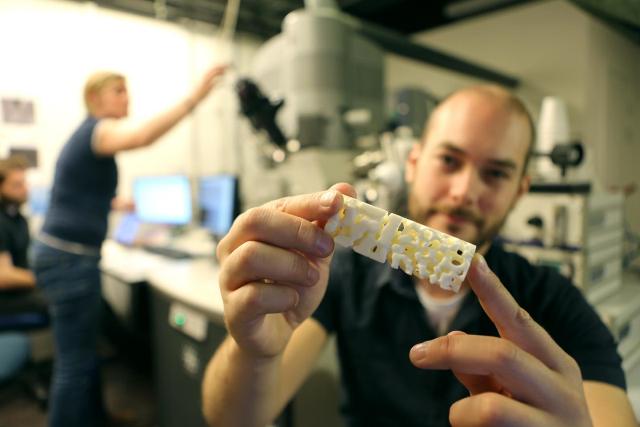A new model of developing robust and lightweight materials, which involves the inclusion of air pockets to give a stiff foam structure, has been discovered. The lead researchers drew inspiration from the tough exoskeleton of sea urchins; which have the same constituents as chalk and contain 70% air, yet are extremely strong.
 A heavily enlarged 3-D print of the sea urchin shell. Credit: Jes Andersen/ University of Copenhagen.
A heavily enlarged 3-D print of the sea urchin shell. Credit: Jes Andersen/ University of Copenhagen.
Material scientists are often inspired by the nature around them, both on the land and at sea.
The brilliant sheen of mother-of-pearl inspires researchers to create smooth surfaces, whilst tightly clasped clams inspire them to develop powerful gluey. Materials used in swimsuits that reduce the drag in water mimic the skin of sharks.
Now it is the turn of sea urchins to inspire scientists. Researchers from the University of Copenhagen have drawn inspiration from the heart urchin, named for their heart-like shape, in the development of strong, yet extremely light, materials.
Soft Animals with Hard Shells
Heart urchins (also known as sea potatoes) live buried in sand where they feed on organic particles present in water by extending a channel above their burrow. Like most urchins they have a soft interior which is protected by a strong exoskeleton which consists of calcium carbonate.
Beach Walk Inspired Research
Dirk Muter, lead researcher of the project, drew inspiration for studying the shells of heart urchins when he was walking along a Croatian beach whilst on vacation. Upon glancing on the urchins washed ashore, Muter observed that though these urchin shells were as thin as a paper they had very few blemishes, despite living in tough environments such as rockbeds and pebbled shores.
Microscopic 3D Pictures
Muter and his team used X-ray microtomography to study the robust calcium carbonate shells. Using this technique, it was possible to create 3D images of the shell's contents without breaking the shells themselves. The X-ray images enabled the scientists to distinguish the structure with a resolution of up to one-thousandth of a millimeter. With such a high resolution, the team were able to gain comprehensive insights into why the shells were so strong.
Chalk Foam Surprisingly Strong
Chalk, which is made of calcium carbonate, can be broken easily. However, the structure of chalk is very different to the structure of the urchin's exoskeleton which contains far more pockets of air. A close up of the shell's structure reveals formations that resembles soapsuds, with numerous microscopic air cavities surrounded by thin struts of calcium carbonate. There are as many as 50,000 to 150,000 struts per mm3 of the material, which consists of 70% air.
Withstands Enormous Pressure
Calcium carbonate shows varying characteristics depending on its crystal structure. This ranges from strong and sturdy marble to the soft, brittle chalk used for writing. The porosity of writing chalk and heart urchins is similar, but the heart urchin exhibits six times the strength of chalk. The structure of heart urchins is close to the strength is a result of it's foam structure, which is essential for survival at a depth of 10 m water plus 30 cm of sand.